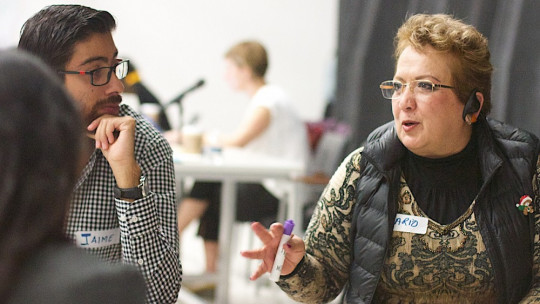
A good conversation based on sincerity and the free exchange of opinions is something as valuable as it is difficult to find. And this is not because there are very few people capable of connecting with us, but because we have adopted a way of relating that makes us pay close attention to the need to keep our distance.
Social relationships are full of rigid rules that, on many occasions, instead of ensuring our individual well-being, make it difficult for us to enjoy honest dialogues through which to connect with others. Because of them, every day we are losing the opportunity to have fascinating conversations that go far beyond the superficial.
But… what would happen if we learned ways to make others more open to us? Not just our friends and family, but all kinds of people we have just met or with whom we have not yet exchanged a word. The possibility of easily connecting with someone in line at the supermarket, at a party with friends or at the entrance to the library is something we should not give up for the simple fear of not knowing how to break the ice.
Connect with others honestly
If leaving shyness and mistrust behind is already complicated, once we have achieved it, we still have to face another challenge: deactivate the barriers that others put in place between them and us.
However, there are simple strategies that can help us solve these types of problems in a simple way. And, in social relationships, simplicity is usually the best tool against communication crises and empathy. Below we will look at some of these effective strategies for getting others to open up and express who they are to us in a more meaningful way.
1. Take the helm of the dialogue
If we are considering adopting ways to make someone open up more to us, it is because they initially adopt a slightly distant or reserved position, even if unconsciously. This psychological barrier will be there during the first moments of dialogue, and we can do little to avoid this, so our task will be to make the other person understand during the first minutes or even seconds that they are wasting unnecessary efforts by keeping that wall up. that keeps her isolated.
The best way to connect with someone is take control of the conversation, even if it’s just at the beginning In this way, our interlocutor adopts a more comfortable role, which leads him to relax. That is why during the first minutes there is no need to worry if we talk much more than the other person; After all, if the other person listens to us, we are giving them more opportunities to find ways to continue the conversation by offering answers.
Little by little, the security and comfort that the role of listener offers It teaches that there is nothing to lose by becoming more involved in dialogue, and that awakens in others the interest in expanding their power of influence. Furthermore, by the time you begin to participate more proactively in the dialogue, we will have explained so much about who we are through what we say that our interlocutor will be more likely to respond to us with more open and honest opinions.
2. Show confidence in yourself
To get others to open up to us, it is very effective. show that we are not afraid of the other person judging us
Although it may seem otherwise, showing this self-confidence will not make the other person adopt a defensive attitude, but rather they will become infected with this state of mind and will even begin to subtly imitate our relaxed posture and the nonchalance that our language reflects. non-verbal, something known in psychology as the chameleon effect. The idea is to express that the same comfort with which one speaks can be adopted by the other.
3. Start with anecdotes and move on to the big themes
Starting to talk about the way you perceive life or your idea of an ideal relationship is often too intimidating. That’s why it’s better introduce these topics by talking about past anecdotes that one has experienced and explain the vital lesson that has been extracted from them.
4. Detect topics to start from
Throughout a conversation, topics appear that allow other lines of dialogue of interest to be drawn up for all the people involved. That is why it is worth detecting these themes and remembering them to, If necessary, resume the dialogue from there
On the other hand, sometimes these topics don’t even have to appear in the conversation; Sometimes, they are provided by the context in which the conversation occurs.
5. Use humor
Humor is an excellent way to relieve tension and to show that behind all those words that come out of our mouths there is a human being who likes to have a good time and find relief in comments that, simple or not, They denote sensitivity and help to empathize
In addition to creating camaraderie, these small humorous touches allow the other person to get hooked on the dialogue by explaining anecdotes.
6. Let your ideology be intuited
Talking about politics with a person who remains distant is not usually the best idea to get them to open up more, but there is something that can be done: let a glimpse of one’s own ideology, once and in a subtle way.
In this way the other person you will no longer have reason to remain on the defensive not knowing this information, and may act accordingly, either showing agreement with that line of opinion or giving up the idea of entering into that topic; In any case, the uncertainty disappears, and that relieves tensions.
7. From the general to the specific
To find out more about the other person without seeming too nosy, it is best to from very basic or obvious information about our interlocutor and, from there, give them the opportunity to go into detail. For example, you can start by talking about your city of residence and end by reviewing opinions about the type of problems that a certain type of neighborhood faces.








